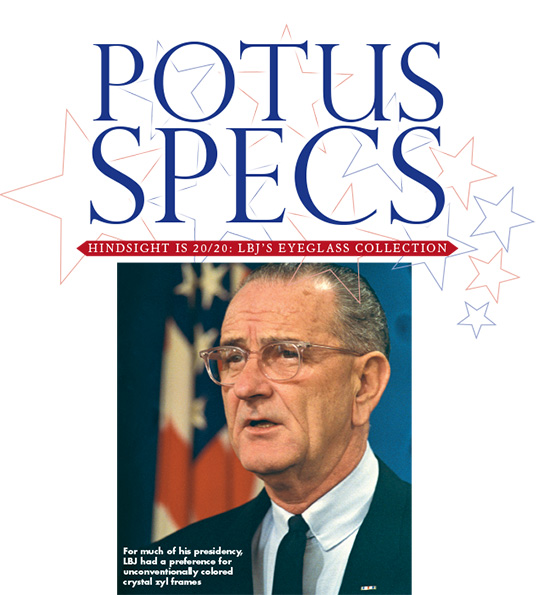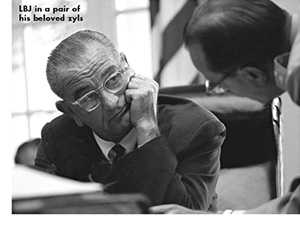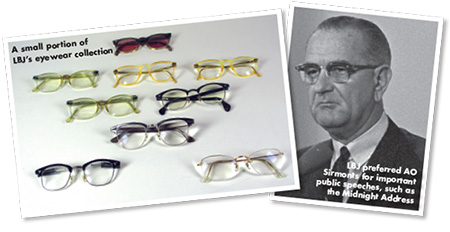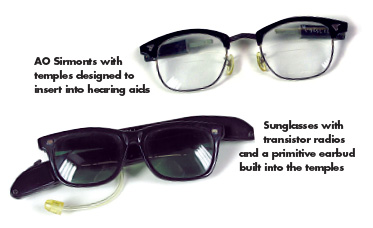
Photos of LBJ courtesy of the LBJ Presidential Library; Photos of eyewear courtesy of the author
BY PRESTON FASSEL
 Tis the season—election season, that is. Of course, this being an optical magazine, we have no official political allegiance (though longtime readers have probably surmised that I’m a staunch supporter of the Browline-Rimless party). But I thought it would be nice to do something that both honors the democratic process and also lets us take a look at a forgotten chapter of optical history. So without further ado, I present you Lyndon B. Johnson—eyeglass collector.
Tis the season—election season, that is. Of course, this being an optical magazine, we have no official political allegiance (though longtime readers have probably surmised that I’m a staunch supporter of the Browline-Rimless party). But I thought it would be nice to do something that both honors the democratic process and also lets us take a look at a forgotten chapter of optical history. So without further ado, I present you Lyndon B. Johnson—eyeglass collector.Especially in today’s media-driven, image-conscious world, it’s rare to see a powerful political figure wearing glasses. The last president to regularly do so was George H.W. Bush, and to find a bespectacled Commander-in-Chief before him, we have to go all the way back to LBJ. While some folks may have an image in their mind of Johnson wearing a pair of American Optical Sirmonts thanks to Bryan Cranston’s acclaimed performance in “All the Way,” that image only scratches the surface of a man who had a penchant for eyewear that rivals my own. In fact, the LBJ Presidential Library and Museum at the University of Texas has in its possession 53 pairs of the President’s eyeglasses.
A look at LBJ’s Rx shows that he definitely needed visual correction. While a man his age would be expected to demonstrate some presbyopia and thus a need for reading glasses—he was 55 when he assumed the presidency— he also suffered from hyperopia, with a distance Rx of +3.50 +1.00 / +4.50 DS. Still, the amount of glasses left behind spoke to something more than just visual correction. After all, how many spares does the average person have—even if that person is the President of the United States? “He frequently kept glasses lying around in case he might need them, especially inside desks and bathrooms and near televisions,” says Joshua Pitt, museum technician at the LBJ Presidential Library and Museum. “He was also prone to switching out glasses frequently for reasons unrelated to correcting his vision, such as if he decided that they didn’t look good on him when he was photographed, or appeared on television.”

This comment, combined with the variety of frames Johnson left behind, paints a picture of an eyewear collector with particular aesthetic sensibilities. He seems to have favored American Optical, Bausch and Lomb, and Victory frames, with ~48-mm eye size. The vast majority are zyl, followed by several browlines and a few Rimway style semi-rimless and full-rim metal pairs. Notably, most of the Rimways are cataloged as explicitly for TV viewing, indicating that the President had preferred styles for different occasions. This is further evinced by footage and photos of Johnson delivering speeches, the most significant of which (the Great Society Speech, the 1964 State of the Union, the speech announcing the signing of the Civil Rights act, the Midnight Address, etc.) feature him wearing browlines. He apparently found them the most flattering, while the abundance of zyls indicates he found plastic most comfortable. Several pairs of zyl sunglasses with apparently purple lenses also indicate that they were favorites, the originally gray dye having been faded by heavy sun exposure, possibly while shooting—a favorite pastime on his ranch, says associate curator Ruth Goerger.
It’s the zyls, particularly, that tell us about the man wearing them: While tortoise, black and faded zyls reached their zenith in popularity during LBJ’s presidency, he seems to have had a penchant for colored frames, with yellow, green and grayish blue making up the majority of the collection. Although not unheard of for the era, they certainly weren’t the most popular colors either and speak to someone who knew what he liked and wore it, regardless of prevailing style dogma—a sort of Optical Johnson Treatment. The condition of some of the zyls is also revealing: The temples of a few pair demonstrate some telltale sausaging, indicating Johnson may have attempted to adjust them himself.

Were all those glasses just a matter of hard-and-fast practicality, though? A pair for every room? It would appear that there was indeed something of a collector’s mentality at play. According to Pitt, “He continued to hold on to glasses even if they no longer met his visual needs. For instance, we have a pair of contact lenses that he held on to despite our records saying explicitly that they did not properly correct his eyesight… Several pairs (of glasses) were received as unsolicited gifts, and while there is little evidence he wore them, he nonetheless held on to them.” Among those gifts are fascinating pieces of period technology: A pair of sunglasses with transistor radios and a primitive earbud built into the temples, and a pair of AO Sirmonts with temples designed to insert into hearing aids.
Above all else, looking at the collection is a very humanizing experience. It’s easy to forget that our politicians—and especially historical figures—have personal lives, with interests that often clash with the public personae they’ve built for themselves. For someone at the focal point of so much American history, it’s strangely humbling to imagine Johnson, away from newsmen and fellow politicians, sitting down as many of us do to ponder such a simple source of joy as a pair of eyeglasses.■
Special thanks to Mark Mattison-Shupnick and Mindi Lewis for answering several period-related optical questions.











